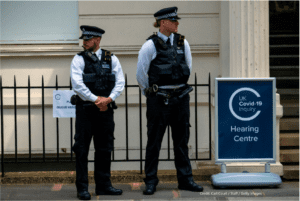“War doesn’t negate decency. It demands it, even more than in times of peace.”
Khaled Hosseini, The Kite Runner
In 2021, the world watched in disbelief as the Taliban took over Kabul, the heart of Afghanistan, almost completely unchallenged. While a whole nation plunged into despair, news headlines in every language echoed the incomprehensible reality: after nearly twenty years of incessant war against the world’s most powerful armies, the Taliban had emerged victorious.
For many, this came as an unwelcome reminder of history’s tendency to repeat itself; while studying the Taliban’s initial takeover in the 1990s, it is difficult not to draw parallels between the draconian rules that oppressed women, the plummeting of human rights, and complete disregard for individual freedoms at the hands of the original regime then and now. At its core, the story of the Taliban and the long drawn-out civil war in Afghanistan is one marked by intermittent U.S. involvement, groups acting in accordance with their own agendas, and the Afghan people getting caught in the crossfire.
The seeds of conflict sprouted in Afghanistan under the Kabul Communist Regime in the 1980s, a highly unpopular government among the rural population for its urban-centric land reforms that disregarded the needs of Afghan farmers. The Mujahideen, an independent militia, formed in response to the crisis and successfully took down the communist government in 1992 using weapons supplied by the U.S. However, even after the successful eviction of the regime, the Mujahideen continued to incite violence across Afghanistan, quickly losing support. In the face of lawlessness and anarchy, a group of students and Mullahs, religious leaders versed in canon law, formed the Taliban, a rebel group that promised to restore order to the nation while compensating for the incumbent government’s failure to cater to the needs of the rural population.
In its earliest stages, the Taliban’s success can be largely attributed to its ability to exploit the open wound of the country’s pre-existing political and social turmoil and propose its own alternative solutions, marketed as the guarantee for a better Afghanistan. Mullahs leveraged religiosity and their considerable influence to maximise recruiting efforts and increase the Taliban’s popularity, and their effect combined with the emergence of Madrassas, religious schools that not only propagated their Islamic ideals but also served as recruitment grounds, allowed the Taliban to exploit the governance gap and appeal to the majority population’s desperate pleas for stability and security. In a nutshell, the Taliban reconstructed the country according to its own interpretation of Islam with the purpose of conflating loyalty to religion with loyalty to the new government, which proved extremely effective in garnering support.
After its five years of rule, the Taliban was successfully driven out following a U.S. rollback invasion in 2001, which catapulted Afghanistan into a period of insurgency against the Afghan government and its Western allies, rendering it a well-contained bubble on the verge of bursting.
As recently as nearly three years ago, after a twenty-year interlude of relative peace, the bubble burst. In honouring Trump’s promise to withdraw 10,000 U.S. troops from Afghanistan, President Joe Biden created the perfect opening for the Taliban to seize power and set up a parallel state for the second time, complete with its own courts and micro-economy backed by the illegal opium trade while simultaneously raising millions in taxes by controlling Afghanistan’s most important highways; according to the UN Security Council, the figure currently lies at approximately 1.5 billion dollars per year.
In 2021, immediately upon the declaration of the Afghan government’s replacement with the Taliban and their storming of the presidential palace, the international community ostracised the new government through the imposition of sanctions and froze Afghanistan’s sovereign assets abroad in hopes of pressuring it to make concessions. However, the biggest victims of this measure were not the Taliban but rather the Afghan people; the sudden withdrawal of international aid had a crippling effect on Afghanistan’s economy, previously constituting 75% of government spending. As a result, central and commercial banks in Afghanistan could no longer function properly, destroying business and trade, and Afghanistan was left with a $500 million budget deficit.
Despite the economic fallback, the Taliban is presenting a new face to citizens and the international community, claiming to be a new, evolved version of its previous state. However, there is a very clear discrepancy between the Taliban’s claims and the realities observed. For one, its ruling methodology relies primarily on the acquisition of power through the means of fear and violence. As such, the targeted killings in the first three months of 2021 can be viewed as a strategic move to make people feel unsafe by sending the message that their current government was falling short, a very similar pretext to how the Taliban first emerged.
Perhaps the most widely repudiated feature of Afghanistan under Taliban rule is the decline of the rights of women and minorities, and the severe restrictions on freedom of expression. In the ‘90s, women were denied access to education and confined to their homes at the mercy of a male relative, severely limiting employment opportunities, and brutal punishments were implemented for perceived violations of Islamic law. This time, things do not seem to be much different. Today, women and girls are not allowed to receive an education, work outside the home, or participate in politics. According to the Human Rights Watch, 87% of Afghan women face abuse in their lifetime, a concerning figure that is projected to worsen with the withdrawal of the international community’s supervision.
As the new government tightens its grip, Afghans and the world alike are left to question whether the Taliban is qualified to take on the monumental task of running a country, and how it will go about resolving the current humanitarian crisis that has 97% of the Afghan population living below the poverty line, hospitals filled to capacity with starving children, and an economy left in shambles.
With no signs of compromise, the fragile progress made over the last 20 years hangs precariously in the balance, threatening not only the lives and liberties of the Afghan people but also the stability of the entire Middle East and beyond.
Taliban Take Over Afghan Presidential Palace – The New York Times (nytimes.com)






